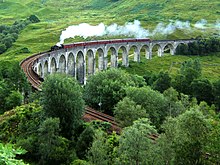Glenfinnan Viaduct
| Glenfinnan Viaduct | |
|---|---|
 |
|
| Coordinates | 56°52′35″N 5°25′55″W / 56.876285°N 5.431914°WCoordinates: 56°52′35″N 5°25′55″W / 56.876285°N 5.431914°W |
| Carries | West Highland Line |
| Crosses | River Finnan |
| Characteristics | |
| Longest span | 50 feet (15 m) |
| No. of spans | 21 |
| History | |
| Engineering design by | Simpson & Wilson |
| Constructed by | Robert McAlpine & Sons |
| Construction begin | 1897 |
| Opened | 1901 |
The Glenfinnan Viaduct is a railway viaduct on the West Highland Line in Glenfinnan, Inverness-shire, Scotland. Located at the top of Loch Shiel in the West Highlands of Scotland, the viaduct overlooks the Glenfinnan Monument and the waters of Loch Shiel.
The West Highland Railway was built to Fort William by Lucas and Aird, but there were delays with the West Highland Railway Mallaig Extension (Guarantee) bill for the Mallaig Extension Railway in the House of Commons as the Tory and Liberal parties fought over the issue of subsidies for public transport. This Act did pass in 1896, by which time Lucas & Aird (and their workers) had moved south. New contractors were needed and Robert McAlpine & Sons were taken on with Simpson & Wilson as engineers. Robert McAlpine & Sons was headed by Robert McAlpine, nicknamed "Concrete Bob" for his innovative use of mass concrete. Concrete was used due to the difficulty of working the hard schist in the area. McAlpine's son Robert, then aged 28, and his nephew William Waddell, took charge of construction, with his younger son Malcolm appointed as assistant.
Construction of the extension from Fort William to Mallaig began in January 1897, and the line opened on 1 April 1901. The Glenfinnan Viaduct, however, was complete enough by October 1898 to be used to transport materials across the valley. It was built at a cost of GB£18,904.
A long-established legend attached to the Glenfinnan Viaduct was that a horse had fallen into one of the piers during construction in 1898 or 1899. In 1987, Professor Roland Paxton failed to find evidence of a horse at Glenfinnan using a fisheye camera inserted into boreholes in the only two piers large enough to accommodate a horse. In 1997, on the basis of local hearsay, he investigated the Loch nan Uamh Viaduct by the same method but found the piers to be full of rubble. Using scanning technology in 2001, the remains of the horse and cart were found at Loch nan Uamh, within the large central pylon.
...
Wikipedia
